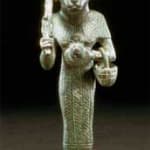Egyptian Bronze Sculpture of Bastet with Gold Earrings, 600 BCE - 300 BCE
Bronze and Gold
4
X.0210
Depicted as a cat-headed female figure, this uninscribed statuette is doubtless to be identified as Bastet because of her attributes. She is wearing a form-fitting, ankle-length dress with short, flared...
Depicted as a cat-headed female figure, this uninscribed statuette is doubtless to be identified as Bastet because of her attributes. She is wearing a form-fitting, ankle-length dress with short, flared sleeves and a V-neck. Linear adjuncts decorate the dress with decorative ornamentation which represents the patterned textile from which the dress was tailored. Patterned textiles are rarely represented in ancient Egyptian art, and its depiction on our Bastet is noteworthy. This depiction of a deluxe and costly garment is complemented by the pair of original boat-shaped earrings of gold which grace our goddess’s pierced ears. Her right arm is bent at the elbow and its elevated hand shakes a naos-shaped sistrum, or sacred rattle. Her left arm, likewise bent at the elbow, is placed on her abdomen with its hand holding an aegis, or ceremonial implement, here consisting of a head of a lioness rising majestically from a broad collar. A basket, crafted from wicker as its reticulated pattern suggests, is suspend by its handle on that arm.
The historical origins of the goddess Bastet may be traced back to the Delta city of Bubastis from which her cult spread. In accordance with the complex conceits of ancient Egyptian religious concepts, powerful, and often destructive forces, had to be appeased and allayed in order to effect their transformation into benevolent, useful powers. In keeping with this conceit, feline goddesses were possessed of opposing characteristics often given visual form in the contrast between a lioness and a cat. The destructive forces associated with felines was often manifest in the lioness as Sakhmet whose belligerent characteristics could be soothed by the playing of a sistrum in order for her to metamorphose into a more docile pussy cat. It is for this reason that our figure of Bastet shakes her sistrum and holds out the aegis of the lioness. These attributes were intended to remind the ancient Egyptians of the two-fold nature of Bastet and how her docile, benevolent nature could turn violent and hostile if adherence to her rituals were not strictly observed.
On the basis of parallels, our Bastet can be dated to the Late Period, and represents a particularly fine example of the type.
References:
For stylistically similar and contemporary examples which, however, neither wear earrings nor hold baskets, see J. Malek, The Cat in Ancient Egypt (London1993), pages 104-105, figures 70, 71, and 73.
The historical origins of the goddess Bastet may be traced back to the Delta city of Bubastis from which her cult spread. In accordance with the complex conceits of ancient Egyptian religious concepts, powerful, and often destructive forces, had to be appeased and allayed in order to effect their transformation into benevolent, useful powers. In keeping with this conceit, feline goddesses were possessed of opposing characteristics often given visual form in the contrast between a lioness and a cat. The destructive forces associated with felines was often manifest in the lioness as Sakhmet whose belligerent characteristics could be soothed by the playing of a sistrum in order for her to metamorphose into a more docile pussy cat. It is for this reason that our figure of Bastet shakes her sistrum and holds out the aegis of the lioness. These attributes were intended to remind the ancient Egyptians of the two-fold nature of Bastet and how her docile, benevolent nature could turn violent and hostile if adherence to her rituals were not strictly observed.
On the basis of parallels, our Bastet can be dated to the Late Period, and represents a particularly fine example of the type.
References:
For stylistically similar and contemporary examples which, however, neither wear earrings nor hold baskets, see J. Malek, The Cat in Ancient Egypt (London1993), pages 104-105, figures 70, 71, and 73.



